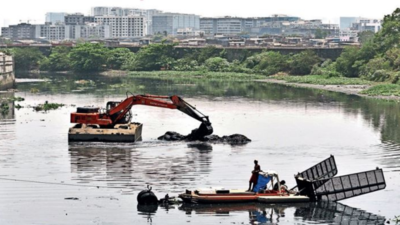- News
- City News
- mumbai News
- BMC to put up floodgates along Mithi at a cost of Rs 2,000 crore
Trending Topics
BMC to put up floodgates along Mithi at a cost of Rs 2,000 crore

The vertical floodgates are expected to eliminate or significantly reduce the need for such relocations in the future
MUMBAI: The BMC has proposed to install 23 vertical floodgates along the 18 km-long Mithi river, which flows from Vihar lake to Mahim creek via Andheri, Kurla and Bandra, to prevent seawater from inundating inland areas during heavy rainfall. The project will cost Rs 2,000 crore.

The installation will begin at the river's mouth in Mahim and extend up to Vihar lake.
Currently, the annual overflow of the Mithi river, especially when high tide and heavy rain in the city coincide during monsoons, necessitates the relocation by the BMC of thousands of residents living around its edges to temporary shelters like municipal schools.
The vertical floodgates are expected to eliminate or significantly reduce the need for such relocations in the future.
Additional municipal commissioner P Velrasu said, "On days when heavy rain coincides with high tide, we do witness water accumulation in the city. Therefore, the BMC is planning to install vertical floodgates along the Mithi. The tender process for it is already underway, and the work is expected to take around three years."
Velrasu was speaking at the Global Coastal Cities Summit 2023 organized by the think tank Mumbai First on Tuesday. He said that as a civic authority, one needs to always consider the worst-case scenario and accordingly roll out solutions.
Mithi's plight first caught attention after the July 26, 2005 deluge in Mumbai, which flooded and sunk many areas adjoining it. Until then, the river was regarded as a natural drain for run-offs from rainwater and slum sewage. An official committee set up to analyse the reasons behind the 2005 deluge had blamed encroachments and clogging in the river. Since then, BMC and MMRDA have spent Rs 1,500 crore for its restoration. About 12 km stretch of the river falls under the jurisdiction of BMC, while the rest is under MMRDA (Mumbai Metropolitan Region Development Authority).
According to Milind Mhaske, CEO of NGO Praja Foundation, if a technology as such is tried and tested globally, there should not be a problem rolling it out in Mumbai. "The city also has the required funds for a project which is expected to alleviate flooding woes. However, the challenge here would be to see if the project is satisfactorily competed within a specified timeline, considering that among the eight pumping stations which were proposed after the July 2005 deluge, two are yet to see the light of day," said Mhaske.

The installation will begin at the river's mouth in Mahim and extend up to Vihar lake.
TimesView
Almost Rs 1,500 crore has been spent already in the past 15 years on cleaning, deepening and widening the Mithi river, and now there are plans to put up floodgates. While any feasible work that prevents flooding is welcome, there has to be some stock-taking on how much money has been spent, what results it has had and at what point spending on rejuvenation is going to stop.
Currently, the annual overflow of the Mithi river, especially when high tide and heavy rain in the city coincide during monsoons, necessitates the relocation by the BMC of thousands of residents living around its edges to temporary shelters like municipal schools.
The vertical floodgates are expected to eliminate or significantly reduce the need for such relocations in the future.
Additional municipal commissioner P Velrasu said, "On days when heavy rain coincides with high tide, we do witness water accumulation in the city. Therefore, the BMC is planning to install vertical floodgates along the Mithi. The tender process for it is already underway, and the work is expected to take around three years."
Velrasu was speaking at the Global Coastal Cities Summit 2023 organized by the think tank Mumbai First on Tuesday. He said that as a civic authority, one needs to always consider the worst-case scenario and accordingly roll out solutions.
Mithi's plight first caught attention after the July 26, 2005 deluge in Mumbai, which flooded and sunk many areas adjoining it. Until then, the river was regarded as a natural drain for run-offs from rainwater and slum sewage. An official committee set up to analyse the reasons behind the 2005 deluge had blamed encroachments and clogging in the river. Since then, BMC and MMRDA have spent Rs 1,500 crore for its restoration. About 12 km stretch of the river falls under the jurisdiction of BMC, while the rest is under MMRDA (Mumbai Metropolitan Region Development Authority).
According to Milind Mhaske, CEO of NGO Praja Foundation, if a technology as such is tried and tested globally, there should not be a problem rolling it out in Mumbai. "The city also has the required funds for a project which is expected to alleviate flooding woes. However, the challenge here would be to see if the project is satisfactorily competed within a specified timeline, considering that among the eight pumping stations which were proposed after the July 2005 deluge, two are yet to see the light of day," said Mhaske.

About the Author
Richa PintoRicha Pinto is a special correspondent with The Times of India. She covers urban governance & climate change issues. With over a decade of experience in field reporting, she has written extensively on various civic issues affecting Mumbaikars. She graduated in -journalism from the prestigious Mumbai-based St Xavier's College and later pursued a three-year Law degree (L.L.B.) with the University of Mumbai. She regularly tweets about all things that matter to Mumbai on-- @richapintoi.
Start a Conversation
FOLLOW US ON SOCIAL MEDIA
FacebookTwitterInstagramKOO APPYOUTUBE







